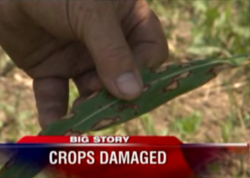Jet-fuel dumping behind Tenn. crop damage some blamed on BP spill
 When a Tennessee TV station aired a report last month on mysterious damage afflicting crops in an area of the mid-South, it set off a firestorm of speculation as to the cause -- with some bloggers blaming it on the BP oil spill in the Gulf of Mexico.
When a Tennessee TV station aired a report last month on mysterious damage afflicting crops in an area of the mid-South, it set off a firestorm of speculation as to the cause -- with some bloggers blaming it on the BP oil spill in the Gulf of Mexico.But it turns out the damage was due to petrochemical spillage of another kind: jet-fuel dumping.
Back on June 1, Shaun Chaiyabhat of WREG in Memphis reported that something was killing crops, trees and even weeds along a large area of farmland near the Shelby and Tipton county border in southwestern Tennessee:
Tiny dots appear to have burned onto leaves of all types of plants, and they appear different depending on the plant.The following week, Yobie Benjamin at the San Francisco-based City Brights blog pointed to the WREG report in a post about the toxic chemical dispersants being applied to the gushing oil in the Gulf of Mexico:
On corn stalks, the dots seem to turn white in the center.
On other plants, a white dust speckles the leaves and then destroys the green life underneath.
A mysterious "disease" has caused widespread damage to plants from weeds to farmed organic and conventionally grown crops. There is very strong suspicion that ocean winds have blown Corexit aerosol plumes or droplets and that dispersants have caused the unexplained widespread damage or "disease".Benjamin linked to a copy of the WREG video with the title, "Could BP's dispersants cause apocalyptic rains." While acknowledging that his linking of the chemical dispersant to plant problems was "conjecture," he asserted that "[t]here is no other explanation for the crop damage." His claims were soon echoed on other blogs.
But in fact, there is another explanation for the crop damage -- one that highlights the ubiquity of petrochemical pollution.
Last week, WREG aired a follow-up report to its original story in which FedEx, which is headquartered in Memphis, admitted to dumping jet fuel over the affected area:
Early on May 28th, FedEx flight 1454 took off, but quickly had trouble in the skies over Millington. Investigators think it dumped as much as 10,000 pounds of fuel onto the farmland. The burned spots appeared almost immediately. Experts do not expect them to have a huge impact, but farmers say it's too soon to tell.Fuel dumping is used to reduce an aircraft's weight in emergency situations, such as when a plane needs to return to the departure airport because of mechanical problems or passenger illness. The dumping allows the craft to meet maximum landing weight requirements.
According to a 2001 letter from the Environmental Protection Agency to an aviation watchdog group that expressed concerns about public health impacts of the practice, fuel dumping occurs only about 127 times a year:
Fuel dumping is uncommon not only because it is an emergency action, but also because it is economically imprudent for an airline to take such action unless it is an emergency.The EPA said that it believes the environmental impact of the practice "would not be serious" because the fuel would "likely be dispersed over a very large area," with fuel released at an altitude above 5,000 feet expected to "evaporate completely" before it hits the ground. But as shown by the incident in Tennessee, where the FedEx plane was reportedly at 5,000 feet when the dumping occurred, that's not necessarily the case.
There have been growing concerns in recent years over the environmental impact of fuel dumping. In May, a malfunctioning Continental airplane dumped 170,000 pounds of jet fuel over part of New Jersey when it needed to return to Newark Airport. The Congressman representing that area has called for an investigation into the environmental and health implications.
And last year, the state of Washington launched an investigation after Asiana Airlines dumped about 5,000 gallons of fuel over Puget Sound. An oil sheen was seen on the water following the incident.
Fuel dumping on a large scale occurred on Sept. 11, 2001 when U.S. airspace was closed due to terrorist attacks on New York and Washington. Many international flights were diverted into Canadian airspace and had to dump fuel in order to land safely.
Fuel dumped from planes can be transported by the wind and transformed photochemically to ozone and other components of smog, according to the U.S. Agency for Toxic Substances and Disease Registry. It's made up of various toxic hydrocarbons including benzene, which has been linked to cancer. Jet fuel also contains a number of additives including biocides to control bacterial and fungal growth in aircraft fuel systems.
FedEx is planning to conduct its own investigation into the incident. It has asked people who believe they were affected by the fuel dumping to contact its Liability Claims office in Memphis.
(Image above is a still from WREG's June 1 news report.)
Tags
Sue Sturgis
Sue is the former editorial director of Facing South and the Institute for Southern Studies.
